An Analysis of Sustainable Energy Use and Development Goals
VerifiedAdded on 2023/05/31
|10
|2629
|242
Essay
AI Summary
This essay delves into the critical role of sustainable energy in achieving the United Nations' Sustainable Development Goals (SDGs). It begins by introducing the SDGs, emphasizing the interconnectedness of the 17 goals and highlighting the central importance of energy, particularly SDG 7, which focuses on ensuring access to affordable, reliable, sustainable, and modern energy. The essay explores how energy influences various SDGs, including those related to poverty, hunger, education, health, and gender equality. It then identifies key challenges in achieving sustainable energy goals, such as monetary obstacles, pricing and regulatory issues, and the need for efficient business models. The essay proposes potential solutions, including railway transportation, smart grids, and alternative fuel vehicles. The conclusion reinforces the necessity of sustainable energy for global development, emphasizing its role in poverty reduction and creating a sustainable future.
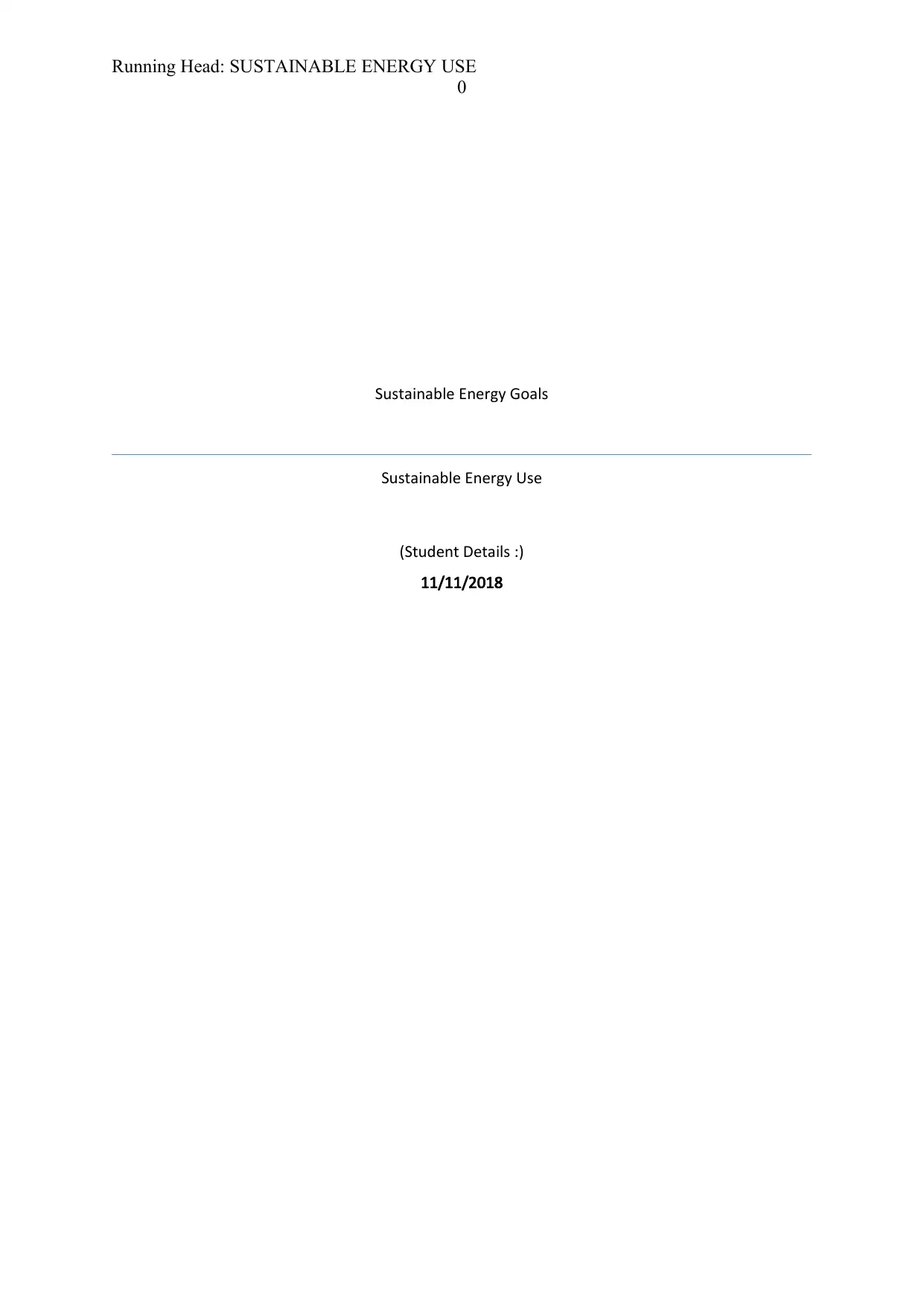
Running Head: SUSTAINABLE ENERGY USE
0
Sustainable Energy Goals
Sustainable Energy Use
(Student Details :)
11/11/2018
0
Sustainable Energy Goals
Sustainable Energy Use
(Student Details :)
11/11/2018
Paraphrase This Document
Need a fresh take? Get an instant paraphrase of this document with our AI Paraphraser
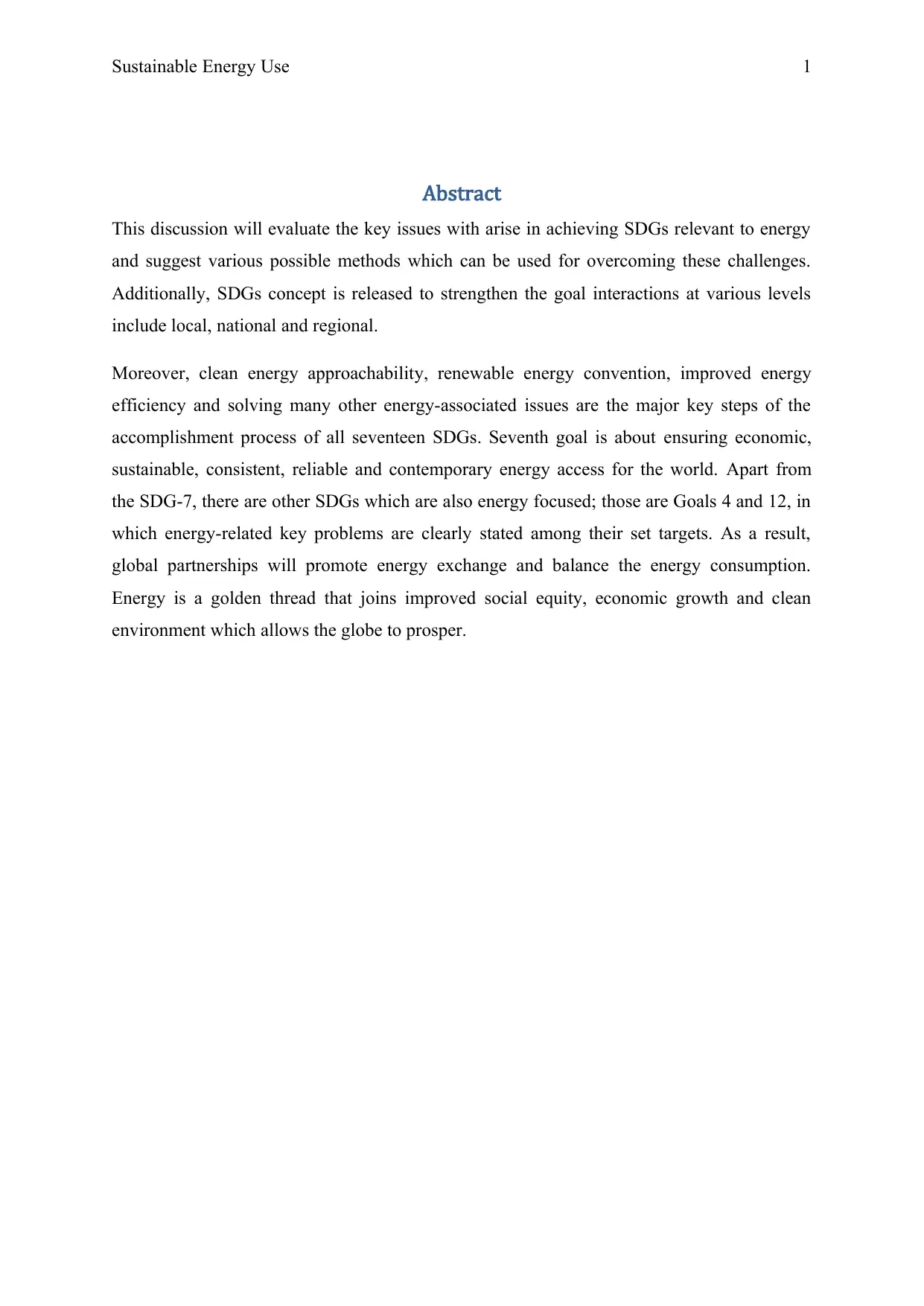
Sustainable Energy Use 1
Abstract
This discussion will evaluate the key issues with arise in achieving SDGs relevant to energy
and suggest various possible methods which can be used for overcoming these challenges.
Additionally, SDGs concept is released to strengthen the goal interactions at various levels
include local, national and regional.
Moreover, clean energy approachability, renewable energy convention, improved energy
efficiency and solving many other energy-associated issues are the major key steps of the
accomplishment process of all seventeen SDGs. Seventh goal is about ensuring economic,
sustainable, consistent, reliable and contemporary energy access for the world. Apart from
the SDG-7, there are other SDGs which are also energy focused; those are Goals 4 and 12, in
which energy-related key problems are clearly stated among their set targets. As a result,
global partnerships will promote energy exchange and balance the energy consumption.
Energy is a golden thread that joins improved social equity, economic growth and clean
environment which allows the globe to prosper.
Abstract
This discussion will evaluate the key issues with arise in achieving SDGs relevant to energy
and suggest various possible methods which can be used for overcoming these challenges.
Additionally, SDGs concept is released to strengthen the goal interactions at various levels
include local, national and regional.
Moreover, clean energy approachability, renewable energy convention, improved energy
efficiency and solving many other energy-associated issues are the major key steps of the
accomplishment process of all seventeen SDGs. Seventh goal is about ensuring economic,
sustainable, consistent, reliable and contemporary energy access for the world. Apart from
the SDG-7, there are other SDGs which are also energy focused; those are Goals 4 and 12, in
which energy-related key problems are clearly stated among their set targets. As a result,
global partnerships will promote energy exchange and balance the energy consumption.
Energy is a golden thread that joins improved social equity, economic growth and clean
environment which allows the globe to prosper.
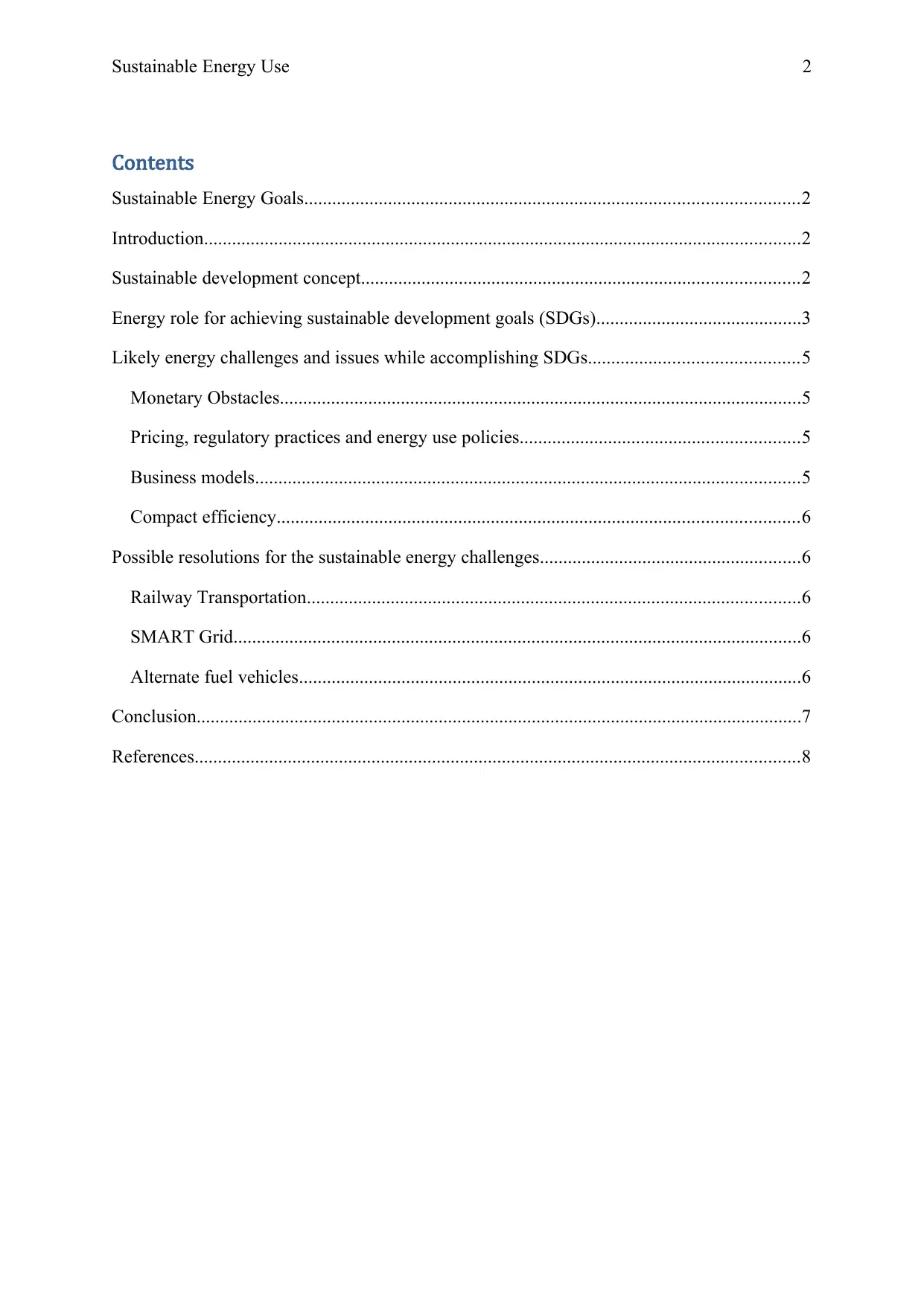
Sustainable Energy Use 2
Contents
Sustainable Energy Goals..........................................................................................................2
Introduction................................................................................................................................2
Sustainable development concept..............................................................................................2
Energy role for achieving sustainable development goals (SDGs)............................................3
Likely energy challenges and issues while accomplishing SDGs.............................................5
Monetary Obstacles................................................................................................................5
Pricing, regulatory practices and energy use policies............................................................5
Business models.....................................................................................................................5
Compact efficiency................................................................................................................6
Possible resolutions for the sustainable energy challenges........................................................6
Railway Transportation..........................................................................................................6
SMART Grid..........................................................................................................................6
Alternate fuel vehicles............................................................................................................6
Conclusion..................................................................................................................................7
References..................................................................................................................................8
Contents
Sustainable Energy Goals..........................................................................................................2
Introduction................................................................................................................................2
Sustainable development concept..............................................................................................2
Energy role for achieving sustainable development goals (SDGs)............................................3
Likely energy challenges and issues while accomplishing SDGs.............................................5
Monetary Obstacles................................................................................................................5
Pricing, regulatory practices and energy use policies............................................................5
Business models.....................................................................................................................5
Compact efficiency................................................................................................................6
Possible resolutions for the sustainable energy challenges........................................................6
Railway Transportation..........................................................................................................6
SMART Grid..........................................................................................................................6
Alternate fuel vehicles............................................................................................................6
Conclusion..................................................................................................................................7
References..................................................................................................................................8
⊘ This is a preview!⊘
Do you want full access?
Subscribe today to unlock all pages.

Trusted by 1+ million students worldwide
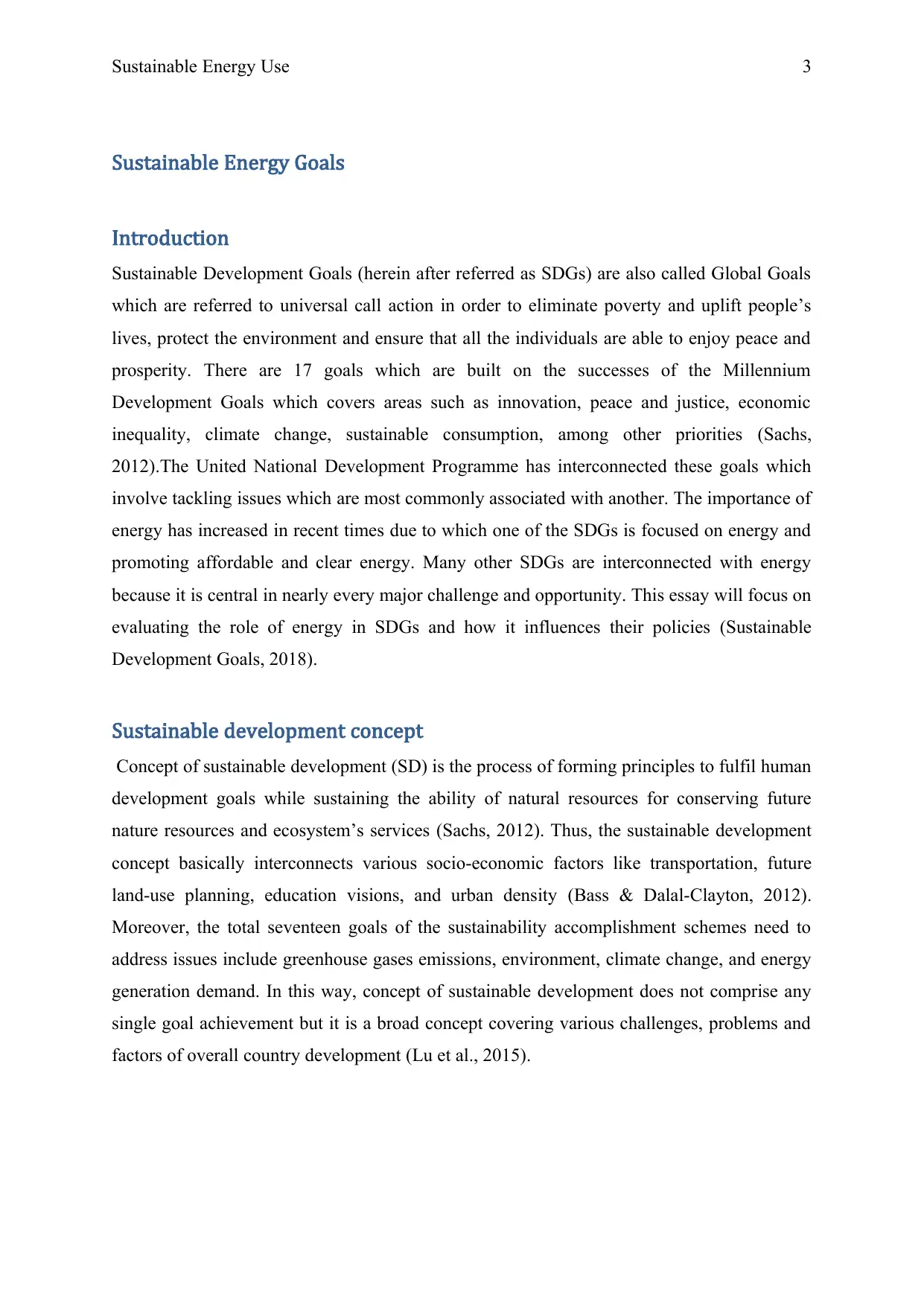
Sustainable Energy Use 3
Sustainable Energy Goals
Introduction
Sustainable Development Goals (herein after referred as SDGs) are also called Global Goals
which are referred to universal call action in order to eliminate poverty and uplift people’s
lives, protect the environment and ensure that all the individuals are able to enjoy peace and
prosperity. There are 17 goals which are built on the successes of the Millennium
Development Goals which covers areas such as innovation, peace and justice, economic
inequality, climate change, sustainable consumption, among other priorities (Sachs,
2012).The United National Development Programme has interconnected these goals which
involve tackling issues which are most commonly associated with another. The importance of
energy has increased in recent times due to which one of the SDGs is focused on energy and
promoting affordable and clear energy. Many other SDGs are interconnected with energy
because it is central in nearly every major challenge and opportunity. This essay will focus on
evaluating the role of energy in SDGs and how it influences their policies (Sustainable
Development Goals, 2018).
Sustainable development concept
Concept of sustainable development (SD) is the process of forming principles to fulfil human
development goals while sustaining the ability of natural resources for conserving future
nature resources and ecosystem’s services (Sachs, 2012). Thus, the sustainable development
concept basically interconnects various socio-economic factors like transportation, future
land-use planning, education visions, and urban density (Bass & Dalal-Clayton, 2012).
Moreover, the total seventeen goals of the sustainability accomplishment schemes need to
address issues include greenhouse gases emissions, environment, climate change, and energy
generation demand. In this way, concept of sustainable development does not comprise any
single goal achievement but it is a broad concept covering various challenges, problems and
factors of overall country development (Lu et al., 2015).
Sustainable Energy Goals
Introduction
Sustainable Development Goals (herein after referred as SDGs) are also called Global Goals
which are referred to universal call action in order to eliminate poverty and uplift people’s
lives, protect the environment and ensure that all the individuals are able to enjoy peace and
prosperity. There are 17 goals which are built on the successes of the Millennium
Development Goals which covers areas such as innovation, peace and justice, economic
inequality, climate change, sustainable consumption, among other priorities (Sachs,
2012).The United National Development Programme has interconnected these goals which
involve tackling issues which are most commonly associated with another. The importance of
energy has increased in recent times due to which one of the SDGs is focused on energy and
promoting affordable and clear energy. Many other SDGs are interconnected with energy
because it is central in nearly every major challenge and opportunity. This essay will focus on
evaluating the role of energy in SDGs and how it influences their policies (Sustainable
Development Goals, 2018).
Sustainable development concept
Concept of sustainable development (SD) is the process of forming principles to fulfil human
development goals while sustaining the ability of natural resources for conserving future
nature resources and ecosystem’s services (Sachs, 2012). Thus, the sustainable development
concept basically interconnects various socio-economic factors like transportation, future
land-use planning, education visions, and urban density (Bass & Dalal-Clayton, 2012).
Moreover, the total seventeen goals of the sustainability accomplishment schemes need to
address issues include greenhouse gases emissions, environment, climate change, and energy
generation demand. In this way, concept of sustainable development does not comprise any
single goal achievement but it is a broad concept covering various challenges, problems and
factors of overall country development (Lu et al., 2015).
Paraphrase This Document
Need a fresh take? Get an instant paraphrase of this document with our AI Paraphraser
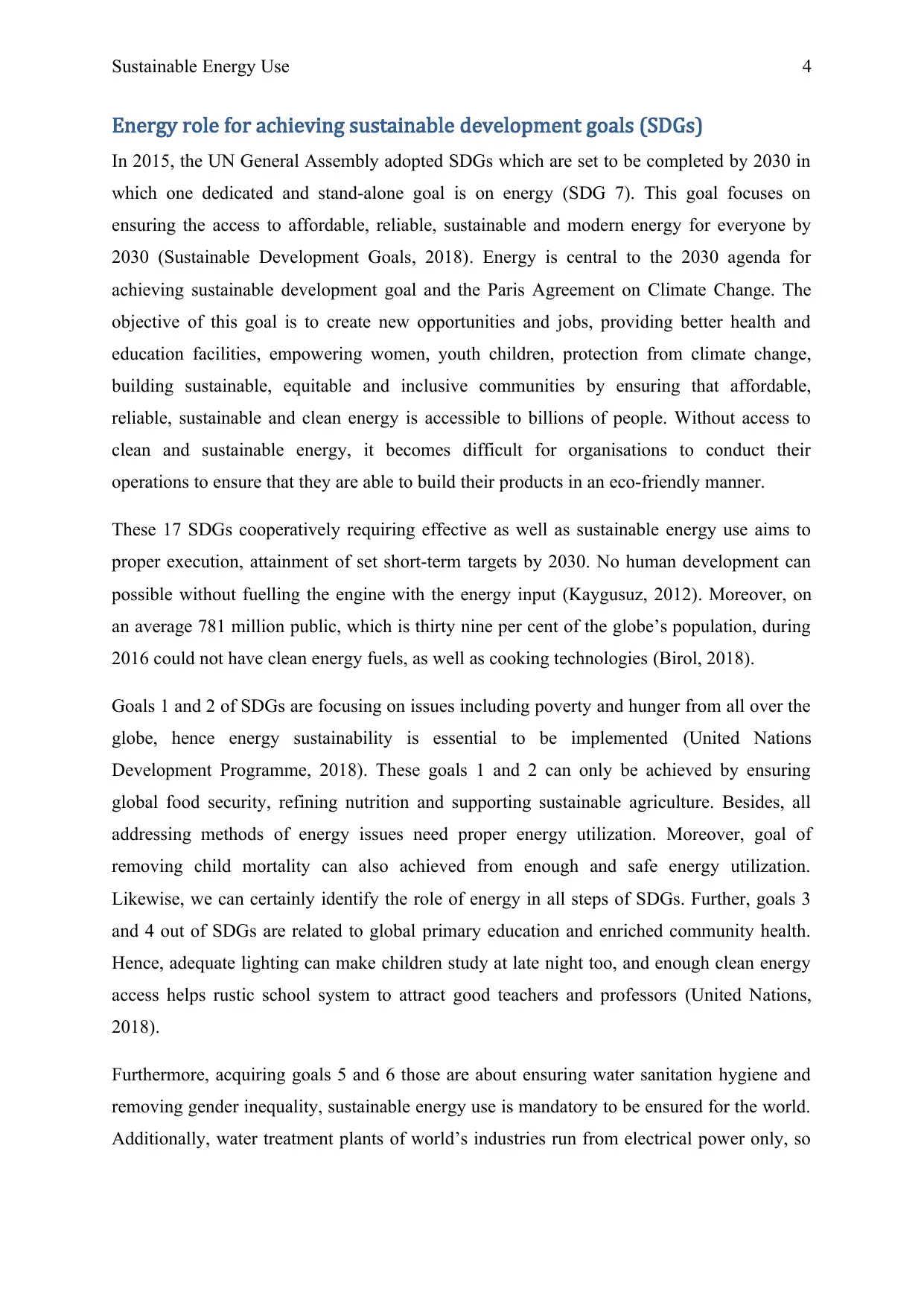
Sustainable Energy Use 4
Energy role for achieving sustainable development goals (SDGs)
In 2015, the UN General Assembly adopted SDGs which are set to be completed by 2030 in
which one dedicated and stand-alone goal is on energy (SDG 7). This goal focuses on
ensuring the access to affordable, reliable, sustainable and modern energy for everyone by
2030 (Sustainable Development Goals, 2018). Energy is central to the 2030 agenda for
achieving sustainable development goal and the Paris Agreement on Climate Change. The
objective of this goal is to create new opportunities and jobs, providing better health and
education facilities, empowering women, youth children, protection from climate change,
building sustainable, equitable and inclusive communities by ensuring that affordable,
reliable, sustainable and clean energy is accessible to billions of people. Without access to
clean and sustainable energy, it becomes difficult for organisations to conduct their
operations to ensure that they are able to build their products in an eco-friendly manner.
These 17 SDGs cooperatively requiring effective as well as sustainable energy use aims to
proper execution, attainment of set short-term targets by 2030. No human development can
possible without fuelling the engine with the energy input (Kaygusuz, 2012). Moreover, on
an average 781 million public, which is thirty nine per cent of the globe’s population, during
2016 could not have clean energy fuels, as well as cooking technologies (Birol, 2018).
Goals 1 and 2 of SDGs are focusing on issues including poverty and hunger from all over the
globe, hence energy sustainability is essential to be implemented (United Nations
Development Programme, 2018). These goals 1 and 2 can only be achieved by ensuring
global food security, refining nutrition and supporting sustainable agriculture. Besides, all
addressing methods of energy issues need proper energy utilization. Moreover, goal of
removing child mortality can also achieved from enough and safe energy utilization.
Likewise, we can certainly identify the role of energy in all steps of SDGs. Further, goals 3
and 4 out of SDGs are related to global primary education and enriched community health.
Hence, adequate lighting can make children study at late night too, and enough clean energy
access helps rustic school system to attract good teachers and professors (United Nations,
2018).
Furthermore, acquiring goals 5 and 6 those are about ensuring water sanitation hygiene and
removing gender inequality, sustainable energy use is mandatory to be ensured for the world.
Additionally, water treatment plants of world’s industries run from electrical power only, so
Energy role for achieving sustainable development goals (SDGs)
In 2015, the UN General Assembly adopted SDGs which are set to be completed by 2030 in
which one dedicated and stand-alone goal is on energy (SDG 7). This goal focuses on
ensuring the access to affordable, reliable, sustainable and modern energy for everyone by
2030 (Sustainable Development Goals, 2018). Energy is central to the 2030 agenda for
achieving sustainable development goal and the Paris Agreement on Climate Change. The
objective of this goal is to create new opportunities and jobs, providing better health and
education facilities, empowering women, youth children, protection from climate change,
building sustainable, equitable and inclusive communities by ensuring that affordable,
reliable, sustainable and clean energy is accessible to billions of people. Without access to
clean and sustainable energy, it becomes difficult for organisations to conduct their
operations to ensure that they are able to build their products in an eco-friendly manner.
These 17 SDGs cooperatively requiring effective as well as sustainable energy use aims to
proper execution, attainment of set short-term targets by 2030. No human development can
possible without fuelling the engine with the energy input (Kaygusuz, 2012). Moreover, on
an average 781 million public, which is thirty nine per cent of the globe’s population, during
2016 could not have clean energy fuels, as well as cooking technologies (Birol, 2018).
Goals 1 and 2 of SDGs are focusing on issues including poverty and hunger from all over the
globe, hence energy sustainability is essential to be implemented (United Nations
Development Programme, 2018). These goals 1 and 2 can only be achieved by ensuring
global food security, refining nutrition and supporting sustainable agriculture. Besides, all
addressing methods of energy issues need proper energy utilization. Moreover, goal of
removing child mortality can also achieved from enough and safe energy utilization.
Likewise, we can certainly identify the role of energy in all steps of SDGs. Further, goals 3
and 4 out of SDGs are related to global primary education and enriched community health.
Hence, adequate lighting can make children study at late night too, and enough clean energy
access helps rustic school system to attract good teachers and professors (United Nations,
2018).
Furthermore, acquiring goals 5 and 6 those are about ensuring water sanitation hygiene and
removing gender inequality, sustainable energy use is mandatory to be ensured for the world.
Additionally, water treatment plants of world’s industries run from electrical power only, so
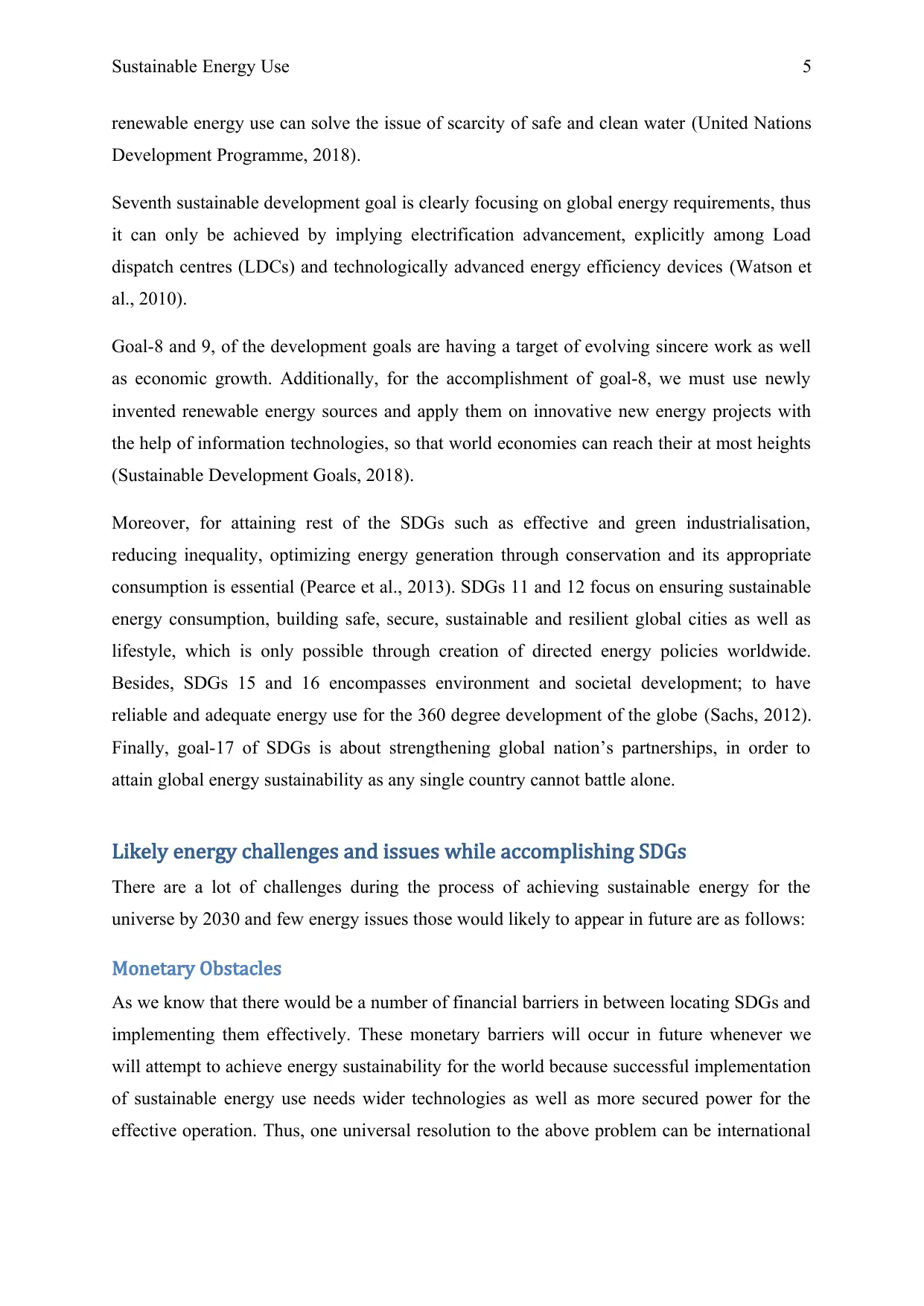
Sustainable Energy Use 5
renewable energy use can solve the issue of scarcity of safe and clean water (United Nations
Development Programme, 2018).
Seventh sustainable development goal is clearly focusing on global energy requirements, thus
it can only be achieved by implying electrification advancement, explicitly among Load
dispatch centres (LDCs) and technologically advanced energy efficiency devices (Watson et
al., 2010).
Goal-8 and 9, of the development goals are having a target of evolving sincere work as well
as economic growth. Additionally, for the accomplishment of goal-8, we must use newly
invented renewable energy sources and apply them on innovative new energy projects with
the help of information technologies, so that world economies can reach their at most heights
(Sustainable Development Goals, 2018).
Moreover, for attaining rest of the SDGs such as effective and green industrialisation,
reducing inequality, optimizing energy generation through conservation and its appropriate
consumption is essential (Pearce et al., 2013). SDGs 11 and 12 focus on ensuring sustainable
energy consumption, building safe, secure, sustainable and resilient global cities as well as
lifestyle, which is only possible through creation of directed energy policies worldwide.
Besides, SDGs 15 and 16 encompasses environment and societal development; to have
reliable and adequate energy use for the 360 degree development of the globe (Sachs, 2012).
Finally, goal-17 of SDGs is about strengthening global nation’s partnerships, in order to
attain global energy sustainability as any single country cannot battle alone.
Likely energy challenges and issues while accomplishing SDGs
There are a lot of challenges during the process of achieving sustainable energy for the
universe by 2030 and few energy issues those would likely to appear in future are as follows:
Monetary Obstacles
As we know that there would be a number of financial barriers in between locating SDGs and
implementing them effectively. These monetary barriers will occur in future whenever we
will attempt to achieve energy sustainability for the world because successful implementation
of sustainable energy use needs wider technologies as well as more secured power for the
effective operation. Thus, one universal resolution to the above problem can be international
renewable energy use can solve the issue of scarcity of safe and clean water (United Nations
Development Programme, 2018).
Seventh sustainable development goal is clearly focusing on global energy requirements, thus
it can only be achieved by implying electrification advancement, explicitly among Load
dispatch centres (LDCs) and technologically advanced energy efficiency devices (Watson et
al., 2010).
Goal-8 and 9, of the development goals are having a target of evolving sincere work as well
as economic growth. Additionally, for the accomplishment of goal-8, we must use newly
invented renewable energy sources and apply them on innovative new energy projects with
the help of information technologies, so that world economies can reach their at most heights
(Sustainable Development Goals, 2018).
Moreover, for attaining rest of the SDGs such as effective and green industrialisation,
reducing inequality, optimizing energy generation through conservation and its appropriate
consumption is essential (Pearce et al., 2013). SDGs 11 and 12 focus on ensuring sustainable
energy consumption, building safe, secure, sustainable and resilient global cities as well as
lifestyle, which is only possible through creation of directed energy policies worldwide.
Besides, SDGs 15 and 16 encompasses environment and societal development; to have
reliable and adequate energy use for the 360 degree development of the globe (Sachs, 2012).
Finally, goal-17 of SDGs is about strengthening global nation’s partnerships, in order to
attain global energy sustainability as any single country cannot battle alone.
Likely energy challenges and issues while accomplishing SDGs
There are a lot of challenges during the process of achieving sustainable energy for the
universe by 2030 and few energy issues those would likely to appear in future are as follows:
Monetary Obstacles
As we know that there would be a number of financial barriers in between locating SDGs and
implementing them effectively. These monetary barriers will occur in future whenever we
will attempt to achieve energy sustainability for the world because successful implementation
of sustainable energy use needs wider technologies as well as more secured power for the
effective operation. Thus, one universal resolution to the above problem can be international
⊘ This is a preview!⊘
Do you want full access?
Subscribe today to unlock all pages.

Trusted by 1+ million students worldwide
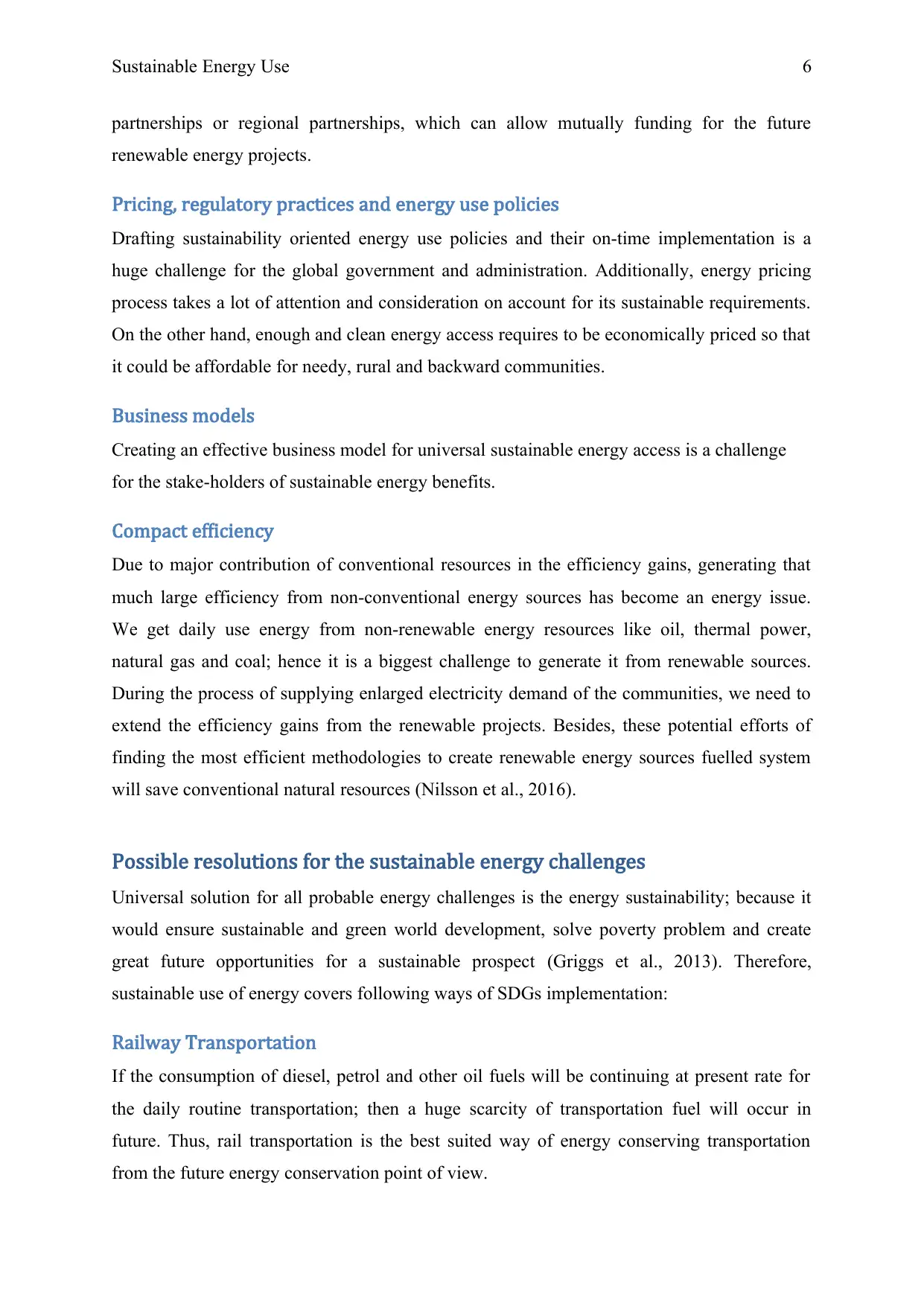
Sustainable Energy Use 6
partnerships or regional partnerships, which can allow mutually funding for the future
renewable energy projects.
Pricing, regulatory practices and energy use policies
Drafting sustainability oriented energy use policies and their on-time implementation is a
huge challenge for the global government and administration. Additionally, energy pricing
process takes a lot of attention and consideration on account for its sustainable requirements.
On the other hand, enough and clean energy access requires to be economically priced so that
it could be affordable for needy, rural and backward communities.
Business models
Creating an effective business model for universal sustainable energy access is a challenge
for the stake-holders of sustainable energy benefits.
Compact efficiency
Due to major contribution of conventional resources in the efficiency gains, generating that
much large efficiency from non-conventional energy sources has become an energy issue.
We get daily use energy from non-renewable energy resources like oil, thermal power,
natural gas and coal; hence it is a biggest challenge to generate it from renewable sources.
During the process of supplying enlarged electricity demand of the communities, we need to
extend the efficiency gains from the renewable projects. Besides, these potential efforts of
finding the most efficient methodologies to create renewable energy sources fuelled system
will save conventional natural resources (Nilsson et al., 2016).
Possible resolutions for the sustainable energy challenges
Universal solution for all probable energy challenges is the energy sustainability; because it
would ensure sustainable and green world development, solve poverty problem and create
great future opportunities for a sustainable prospect (Griggs et al., 2013). Therefore,
sustainable use of energy covers following ways of SDGs implementation:
Railway Transportation
If the consumption of diesel, petrol and other oil fuels will be continuing at present rate for
the daily routine transportation; then a huge scarcity of transportation fuel will occur in
future. Thus, rail transportation is the best suited way of energy conserving transportation
from the future energy conservation point of view.
partnerships or regional partnerships, which can allow mutually funding for the future
renewable energy projects.
Pricing, regulatory practices and energy use policies
Drafting sustainability oriented energy use policies and their on-time implementation is a
huge challenge for the global government and administration. Additionally, energy pricing
process takes a lot of attention and consideration on account for its sustainable requirements.
On the other hand, enough and clean energy access requires to be economically priced so that
it could be affordable for needy, rural and backward communities.
Business models
Creating an effective business model for universal sustainable energy access is a challenge
for the stake-holders of sustainable energy benefits.
Compact efficiency
Due to major contribution of conventional resources in the efficiency gains, generating that
much large efficiency from non-conventional energy sources has become an energy issue.
We get daily use energy from non-renewable energy resources like oil, thermal power,
natural gas and coal; hence it is a biggest challenge to generate it from renewable sources.
During the process of supplying enlarged electricity demand of the communities, we need to
extend the efficiency gains from the renewable projects. Besides, these potential efforts of
finding the most efficient methodologies to create renewable energy sources fuelled system
will save conventional natural resources (Nilsson et al., 2016).
Possible resolutions for the sustainable energy challenges
Universal solution for all probable energy challenges is the energy sustainability; because it
would ensure sustainable and green world development, solve poverty problem and create
great future opportunities for a sustainable prospect (Griggs et al., 2013). Therefore,
sustainable use of energy covers following ways of SDGs implementation:
Railway Transportation
If the consumption of diesel, petrol and other oil fuels will be continuing at present rate for
the daily routine transportation; then a huge scarcity of transportation fuel will occur in
future. Thus, rail transportation is the best suited way of energy conserving transportation
from the future energy conservation point of view.
Paraphrase This Document
Need a fresh take? Get an instant paraphrase of this document with our AI Paraphraser
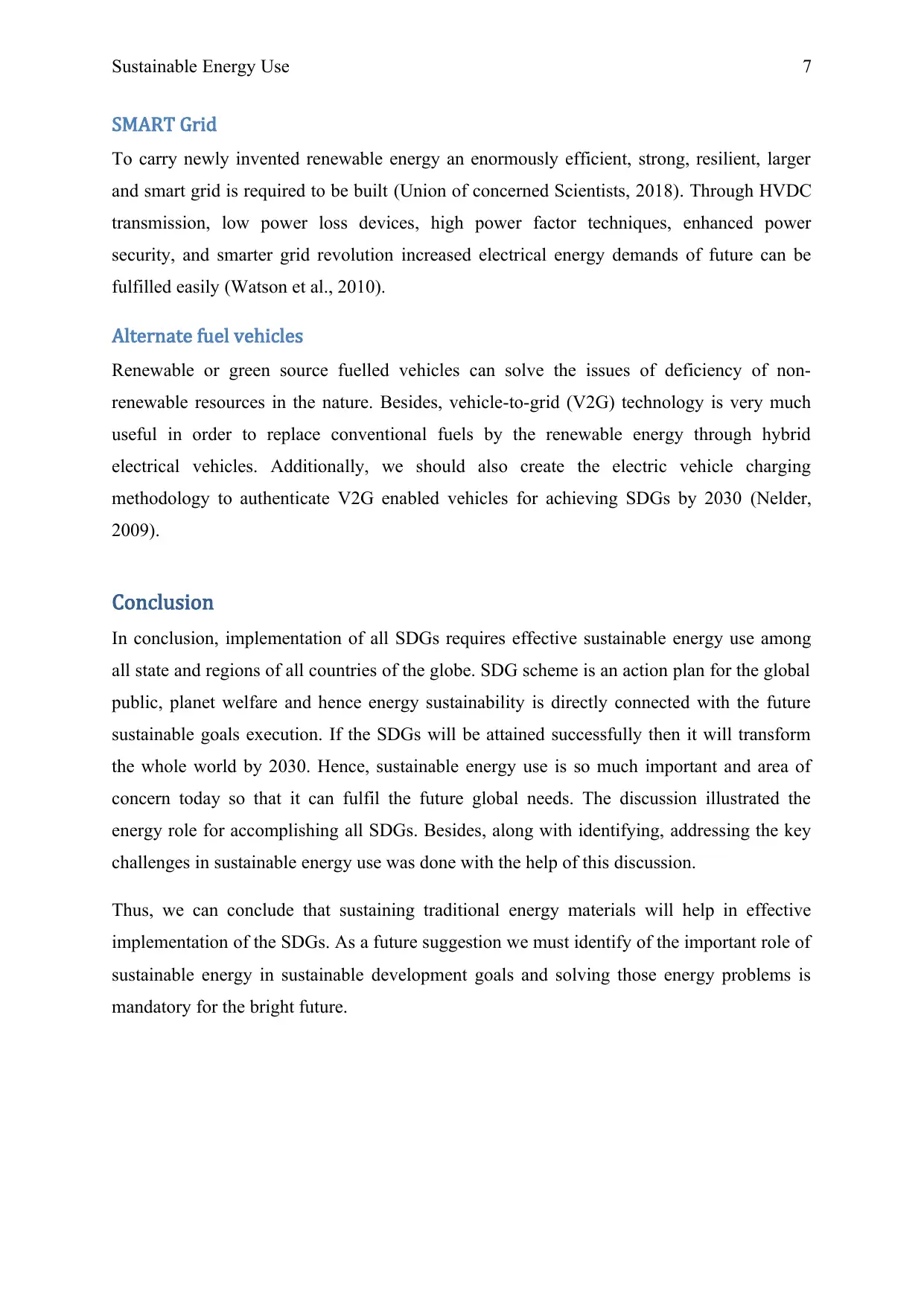
Sustainable Energy Use 7
SMART Grid
To carry newly invented renewable energy an enormously efficient, strong, resilient, larger
and smart grid is required to be built (Union of concerned Scientists, 2018). Through HVDC
transmission, low power loss devices, high power factor techniques, enhanced power
security, and smarter grid revolution increased electrical energy demands of future can be
fulfilled easily (Watson et al., 2010).
Alternate fuel vehicles
Renewable or green source fuelled vehicles can solve the issues of deficiency of non-
renewable resources in the nature. Besides, vehicle-to-grid (V2G) technology is very much
useful in order to replace conventional fuels by the renewable energy through hybrid
electrical vehicles. Additionally, we should also create the electric vehicle charging
methodology to authenticate V2G enabled vehicles for achieving SDGs by 2030 (Nelder,
2009).
Conclusion
In conclusion, implementation of all SDGs requires effective sustainable energy use among
all state and regions of all countries of the globe. SDG scheme is an action plan for the global
public, planet welfare and hence energy sustainability is directly connected with the future
sustainable goals execution. If the SDGs will be attained successfully then it will transform
the whole world by 2030. Hence, sustainable energy use is so much important and area of
concern today so that it can fulfil the future global needs. The discussion illustrated the
energy role for accomplishing all SDGs. Besides, along with identifying, addressing the key
challenges in sustainable energy use was done with the help of this discussion.
Thus, we can conclude that sustaining traditional energy materials will help in effective
implementation of the SDGs. As a future suggestion we must identify of the important role of
sustainable energy in sustainable development goals and solving those energy problems is
mandatory for the bright future.
SMART Grid
To carry newly invented renewable energy an enormously efficient, strong, resilient, larger
and smart grid is required to be built (Union of concerned Scientists, 2018). Through HVDC
transmission, low power loss devices, high power factor techniques, enhanced power
security, and smarter grid revolution increased electrical energy demands of future can be
fulfilled easily (Watson et al., 2010).
Alternate fuel vehicles
Renewable or green source fuelled vehicles can solve the issues of deficiency of non-
renewable resources in the nature. Besides, vehicle-to-grid (V2G) technology is very much
useful in order to replace conventional fuels by the renewable energy through hybrid
electrical vehicles. Additionally, we should also create the electric vehicle charging
methodology to authenticate V2G enabled vehicles for achieving SDGs by 2030 (Nelder,
2009).
Conclusion
In conclusion, implementation of all SDGs requires effective sustainable energy use among
all state and regions of all countries of the globe. SDG scheme is an action plan for the global
public, planet welfare and hence energy sustainability is directly connected with the future
sustainable goals execution. If the SDGs will be attained successfully then it will transform
the whole world by 2030. Hence, sustainable energy use is so much important and area of
concern today so that it can fulfil the future global needs. The discussion illustrated the
energy role for accomplishing all SDGs. Besides, along with identifying, addressing the key
challenges in sustainable energy use was done with the help of this discussion.
Thus, we can conclude that sustaining traditional energy materials will help in effective
implementation of the SDGs. As a future suggestion we must identify of the important role of
sustainable energy in sustainable development goals and solving those energy problems is
mandatory for the bright future.
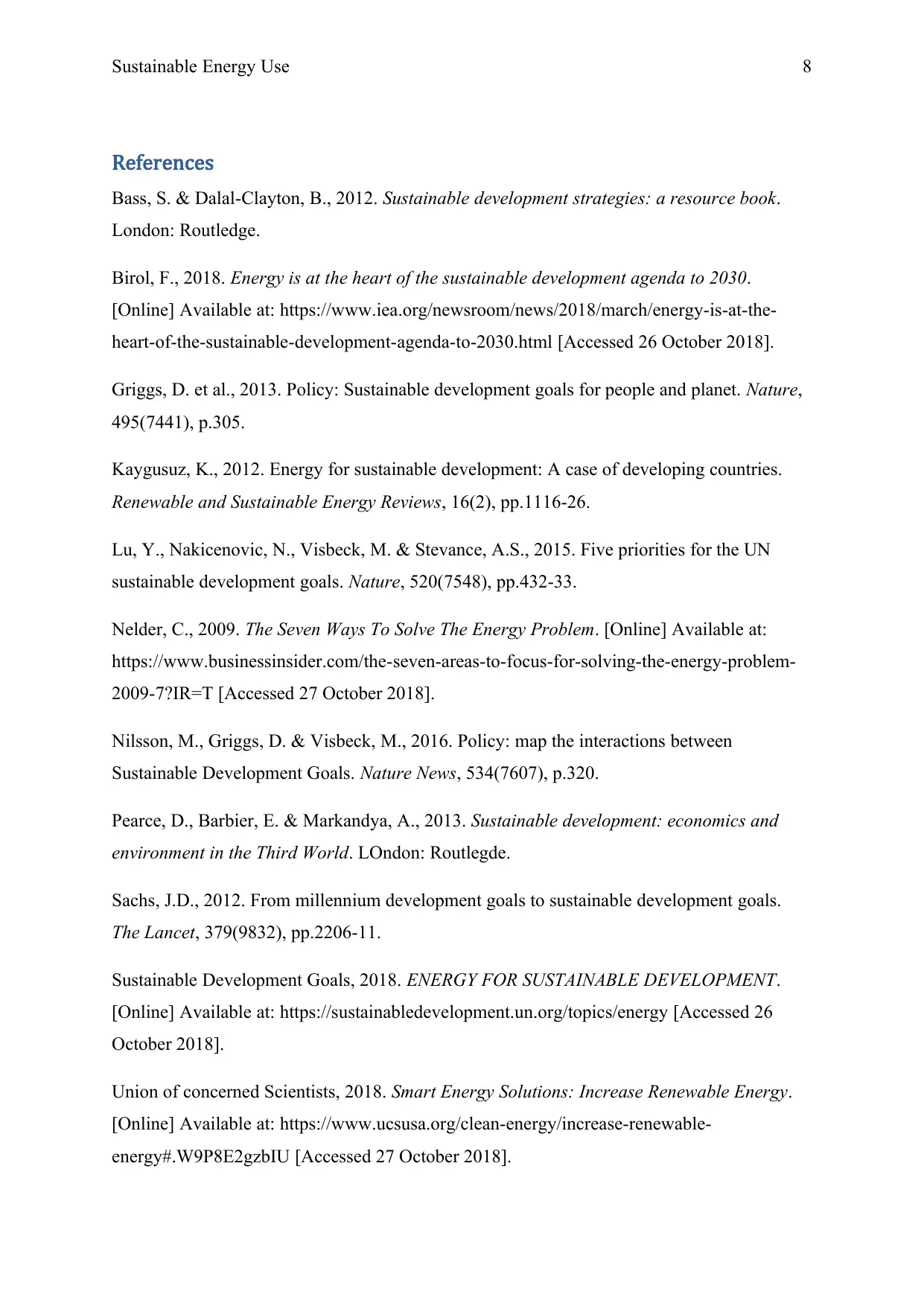
Sustainable Energy Use 8
References
Bass, S. & Dalal-Clayton, B., 2012. Sustainable development strategies: a resource book.
London: Routledge.
Birol, F., 2018. Energy is at the heart of the sustainable development agenda to 2030.
[Online] Available at: https://www.iea.org/newsroom/news/2018/march/energy-is-at-the-
heart-of-the-sustainable-development-agenda-to-2030.html [Accessed 26 October 2018].
Griggs, D. et al., 2013. Policy: Sustainable development goals for people and planet. Nature,
495(7441), p.305.
Kaygusuz, K., 2012. Energy for sustainable development: A case of developing countries.
Renewable and Sustainable Energy Reviews, 16(2), pp.1116-26.
Lu, Y., Nakicenovic, N., Visbeck, M. & Stevance, A.S., 2015. Five priorities for the UN
sustainable development goals. Nature, 520(7548), pp.432-33.
Nelder, C., 2009. The Seven Ways To Solve The Energy Problem. [Online] Available at:
https://www.businessinsider.com/the-seven-areas-to-focus-for-solving-the-energy-problem-
2009-7?IR=T [Accessed 27 October 2018].
Nilsson, M., Griggs, D. & Visbeck, M., 2016. Policy: map the interactions between
Sustainable Development Goals. Nature News, 534(7607), p.320.
Pearce, D., Barbier, E. & Markandya, A., 2013. Sustainable development: economics and
environment in the Third World. LOndon: Routlegde.
Sachs, J.D., 2012. From millennium development goals to sustainable development goals.
The Lancet, 379(9832), pp.2206-11.
Sustainable Development Goals, 2018. ENERGY FOR SUSTAINABLE DEVELOPMENT.
[Online] Available at: https://sustainabledevelopment.un.org/topics/energy [Accessed 26
October 2018].
Union of concerned Scientists, 2018. Smart Energy Solutions: Increase Renewable Energy.
[Online] Available at: https://www.ucsusa.org/clean-energy/increase-renewable-
energy#.W9P8E2gzbIU [Accessed 27 October 2018].
References
Bass, S. & Dalal-Clayton, B., 2012. Sustainable development strategies: a resource book.
London: Routledge.
Birol, F., 2018. Energy is at the heart of the sustainable development agenda to 2030.
[Online] Available at: https://www.iea.org/newsroom/news/2018/march/energy-is-at-the-
heart-of-the-sustainable-development-agenda-to-2030.html [Accessed 26 October 2018].
Griggs, D. et al., 2013. Policy: Sustainable development goals for people and planet. Nature,
495(7441), p.305.
Kaygusuz, K., 2012. Energy for sustainable development: A case of developing countries.
Renewable and Sustainable Energy Reviews, 16(2), pp.1116-26.
Lu, Y., Nakicenovic, N., Visbeck, M. & Stevance, A.S., 2015. Five priorities for the UN
sustainable development goals. Nature, 520(7548), pp.432-33.
Nelder, C., 2009. The Seven Ways To Solve The Energy Problem. [Online] Available at:
https://www.businessinsider.com/the-seven-areas-to-focus-for-solving-the-energy-problem-
2009-7?IR=T [Accessed 27 October 2018].
Nilsson, M., Griggs, D. & Visbeck, M., 2016. Policy: map the interactions between
Sustainable Development Goals. Nature News, 534(7607), p.320.
Pearce, D., Barbier, E. & Markandya, A., 2013. Sustainable development: economics and
environment in the Third World. LOndon: Routlegde.
Sachs, J.D., 2012. From millennium development goals to sustainable development goals.
The Lancet, 379(9832), pp.2206-11.
Sustainable Development Goals, 2018. ENERGY FOR SUSTAINABLE DEVELOPMENT.
[Online] Available at: https://sustainabledevelopment.un.org/topics/energy [Accessed 26
October 2018].
Union of concerned Scientists, 2018. Smart Energy Solutions: Increase Renewable Energy.
[Online] Available at: https://www.ucsusa.org/clean-energy/increase-renewable-
energy#.W9P8E2gzbIU [Accessed 27 October 2018].
⊘ This is a preview!⊘
Do you want full access?
Subscribe today to unlock all pages.

Trusted by 1+ million students worldwide
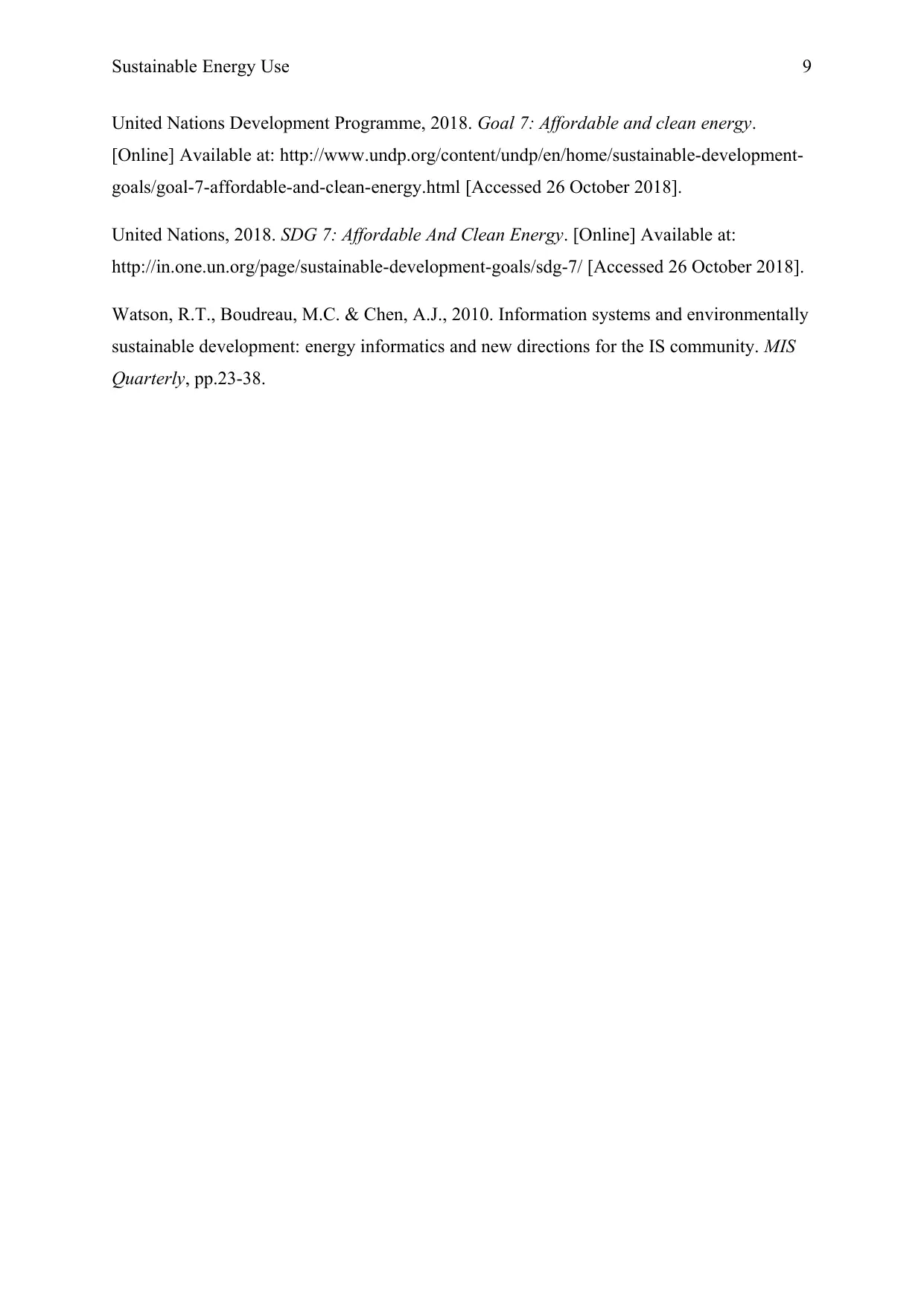
Sustainable Energy Use 9
United Nations Development Programme, 2018. Goal 7: Affordable and clean energy.
[Online] Available at: http://www.undp.org/content/undp/en/home/sustainable-development-
goals/goal-7-affordable-and-clean-energy.html [Accessed 26 October 2018].
United Nations, 2018. SDG 7: Affordable And Clean Energy. [Online] Available at:
http://in.one.un.org/page/sustainable-development-goals/sdg-7/ [Accessed 26 October 2018].
Watson, R.T., Boudreau, M.C. & Chen, A.J., 2010. Information systems and environmentally
sustainable development: energy informatics and new directions for the IS community. MIS
Quarterly, pp.23-38.
United Nations Development Programme, 2018. Goal 7: Affordable and clean energy.
[Online] Available at: http://www.undp.org/content/undp/en/home/sustainable-development-
goals/goal-7-affordable-and-clean-energy.html [Accessed 26 October 2018].
United Nations, 2018. SDG 7: Affordable And Clean Energy. [Online] Available at:
http://in.one.un.org/page/sustainable-development-goals/sdg-7/ [Accessed 26 October 2018].
Watson, R.T., Boudreau, M.C. & Chen, A.J., 2010. Information systems and environmentally
sustainable development: energy informatics and new directions for the IS community. MIS
Quarterly, pp.23-38.
1 out of 10
Related Documents
Your All-in-One AI-Powered Toolkit for Academic Success.
+13062052269
info@desklib.com
Available 24*7 on WhatsApp / Email
![[object Object]](/_next/static/media/star-bottom.7253800d.svg)
Unlock your academic potential
Copyright © 2020–2025 A2Z Services. All Rights Reserved. Developed and managed by ZUCOL.





